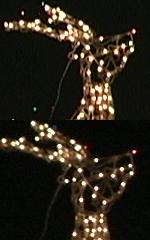
lighted figures, closeup both f/2.8, +0 dB |

lighted figures, wide both f/2.8, +0 dB |

lights out of focus both f/2.8 +12 dB |

lighted figures, closeup both f/2.8, +0 dB |

lighted figures, wide both f/2.8, +0 dB |

lights out of focus both f/2.8 +12 dB |
The top image is from the GL1 and the bottom is from the TRV900. Click on an image to view the full-size 720x480 firewire capture from each camera, and the exposure settings. Both cameras were in progressive-scan mode with 1/60 sec. shutter, and I took both images pressing the "photo" button to record approx. 7 seconds of a still frame to tape. In the first two cases I adjusted the black level to increase apparent contrast on the monitor, but I did exactly the same numerical adjustment (photoshop histogram tool) for each camera. (first two, set black level at +12). In the last case (out-of-focus lights) I did not adjust anything, so you see the raw untouched image from firewire.
It is tricky to focus such images correctly but I tried to do as well as I could. In all cases I am using manual focus; zooming all the way in, adjusting focus for best image, and zooming out to set the shot. Small points of light are a real test of a camera's resolution, and the higher CCD pixel count of the TRV900 seems to serve it well, especially noticible on the wide shot (center image). It is interesting to see the hexagonal patterns of out-of-focus lights on the TRV900 vs. the round images from the GL1 (also larger, as the GL1 can zoom in more).
I used the Photoshop area select and histogram tool, and 5x5 average eyedropper to examine the dark areas of the raw firewire frames in the rightmost fuzzly-lights image (+12dB gain in each camera). The GL1 "black" averages (30,30,26) and the TRV900 "black" averages (20,20,20). These are (R,G,B) values where (255,255,255) is full white. The intensity value histogram forms a gaussian shape with the GL1 spread from (13...44) and the TRV900 spread is from (9...33). (Intensity values measured on a scale 0..255.) This indicates the GL1 has a higher "dark" level and a more noisy image than the TRV900, for the same gain (+12 dB). This was unexpected, since the GL1 has fewer and larger pixels than the TRV900, yet it is 1/2 stop less sensitive overall (in normal light), and more noisy as well in low light. Apparently Sony has a better CCD technology.